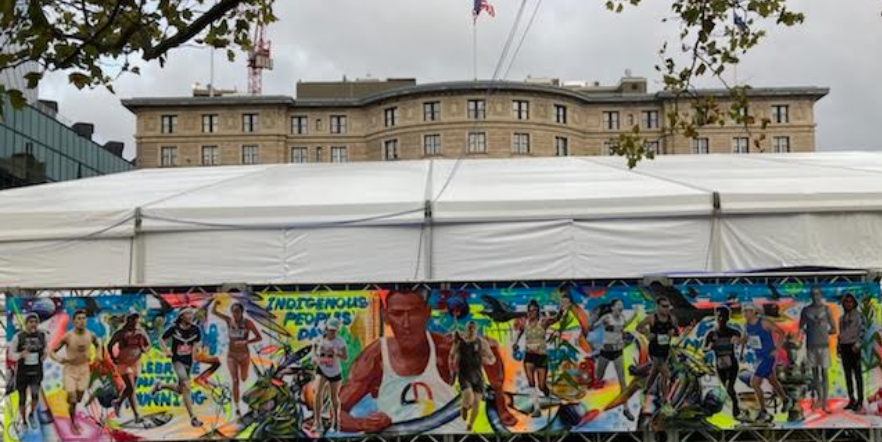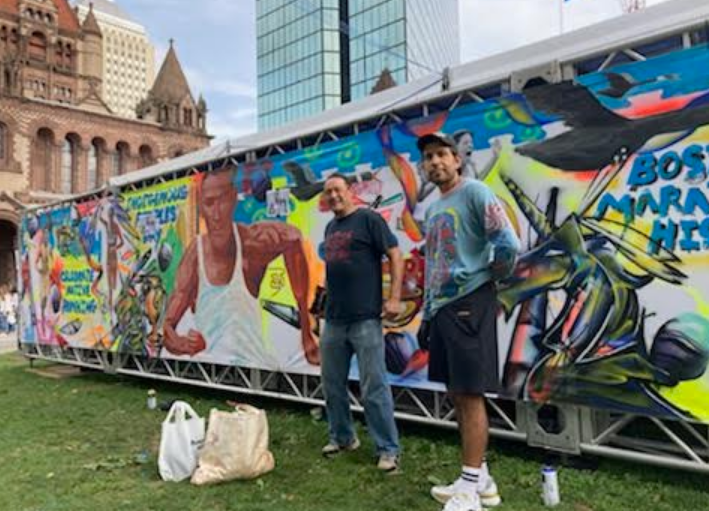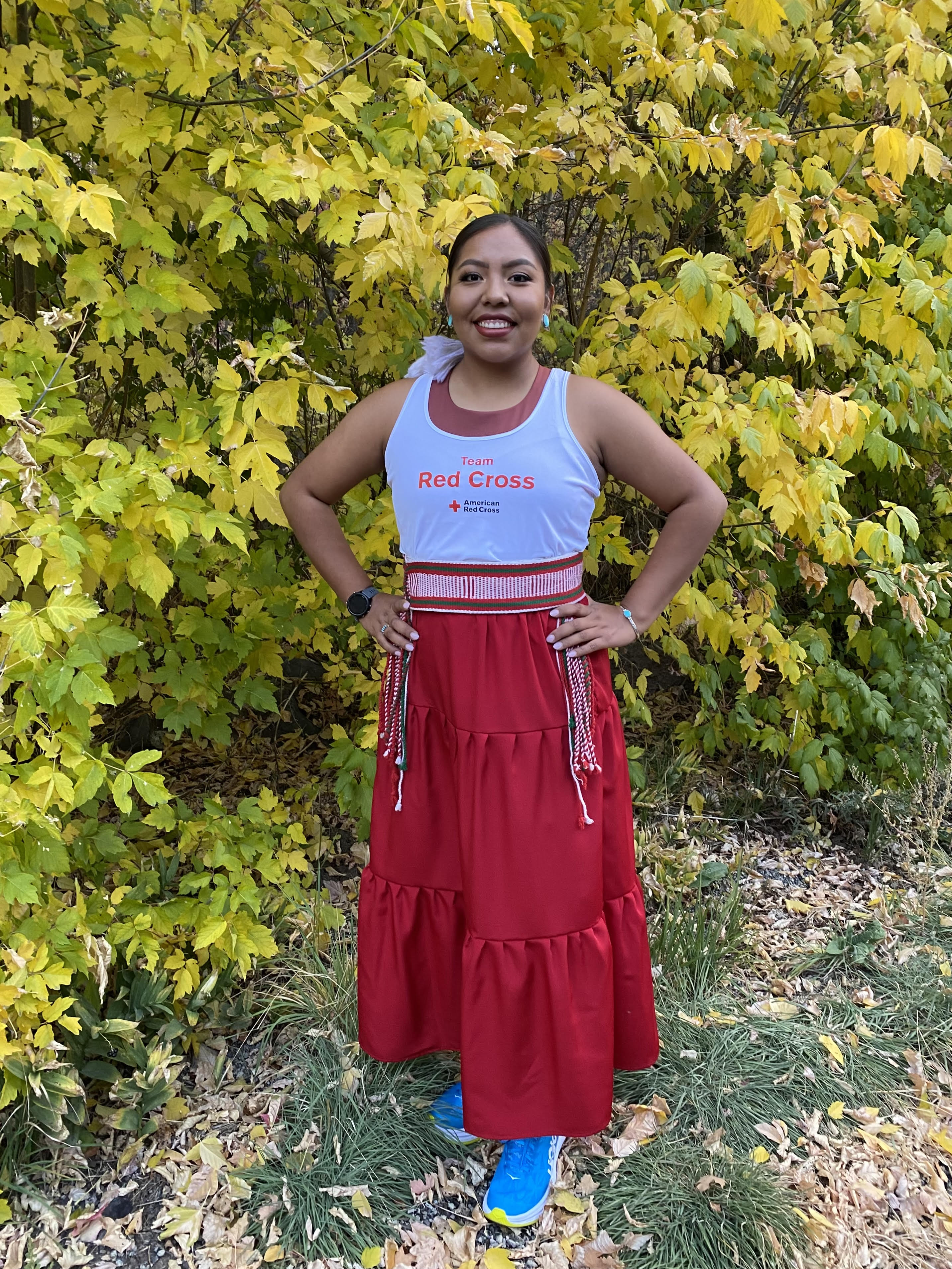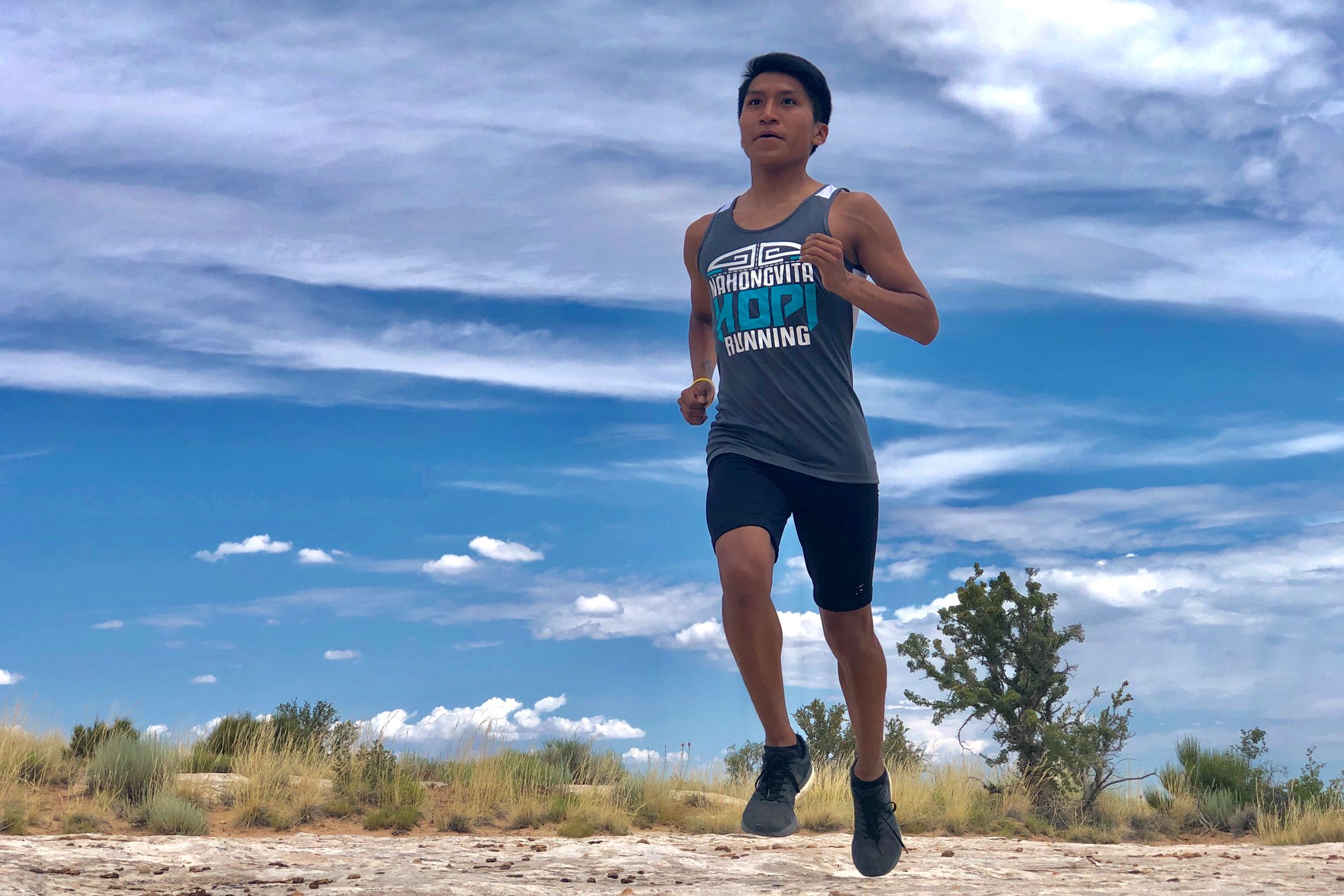
- Details
- By Valerie Vande Panne
This Monday, Indigenous Peoples’ Day, will see athletes from all over the world run the 125th Boston Marathon. The marathon, typically scheduled for a Monday in mid-April, was cancelled last year due to Covid-19, and this year was rescheduled due to the pandemic.
When the Boston Athletic Association (B.A.A.) picked Indigenous Peoples’ Day for their race, local Indigenous activists were outraged. A petition asking for it to be rescheduled garnered over 41,000 signatures, and numerous meetings and conversations occurred. The culmination has led to the Boston Athletic Association publicly apologizing for running the race on Indigenous Peoples’ Day, and working to right some of its wrongs, while Native runners from across Indian Country are running in the marathon with an invigorated sense of purpose
First, correcting a white-washed record
When Ellison “Tarzan” Brown, Narragansett, won the Boston Marathon in 1936 (he also won in 1939), he did so by passing a local Irish American man named John Kelley, who had patronizingly patted Brown on the back--some say bottom--and made some sort of disparaging ‘nice try’ remark to Brown. Brown, according to reports, took off up what was to become the infamous “Heartbreak Hill,” thereby “leaving Kelley in the dust and breaking his heart.” Brown won in 2:33:40; He later became the first person to break the 2:30 mark in 1939 with a time of 2:28:51. He is the only Native American to win the marathon twice. Brown also ran in the 1936 Olympics in Berlin along with Jesse Owens.
Today, despite the fact Brown won that race, there is a statue of Kelley--two John Kelleys in fact, a young one catching up to an older one. Meanwhile, Brown, like other Indigenous and Black athletes of the era, continued to be discounted and marginalized. He was killed in 1975 by someone who deliberately drove over him in a Rhode Island bar’s parking lot.
Want more Native News? Get the free daily newsletter today.
Dr. Darlene Flores, Higuayagua Taíno/Borikua Taíno, of Newton, MA, was outraged when the B.A.A. changed the date. Like most people in metro Boston who know of Heartbreak Hill, she was unaware the runner who beat Kelley was Native American. “Like everyone else, we learn the Euro-centric agenda. It damages Indigenous and the BIPOC people as a whole,” she tells Native News Online. Flores helped start the email and social media campaign to get the B.A.A. to change its date, but, she says, they neither the B.A.A. nor its sponsors or towns the marathon goes through, including Newton, cared. “Capitalism brings revenue to these towns. It’s descrimination. Now Indigenous people have to celebrate with their Indigenous brothers and sisters or run a marathon, and allies, do they go to the marathon or come to a celebration? It splits the people,” she says. Flores also notes--as most in the Boston area can attest to--that the logistics of the marathon virtually shuts down the area. “No athletic event should supercede our holy day… It’s not against the law for us to practice our spirituality
This year, the Boston Athletic Association is honoring Brown’s legacy, in both the opening ceremony and with a highly visible art exhibit, and has told the community it will do a land acknowledgement at the start of the race.
More Marathon Honors
Patti Catalano Dillon, Mi’kmaq, is a 3-time Boston Marathon runner up and the first woman to break 2:30 in the marathon, is serving as “an official starter for the Men’s and Women’s Open Races.” Women weren’t even allowed to officially run in the marathon until 1967.
As part of the Boston Marathon Pursuit Program, the Boston Athletic Association announced it is donating $10,000 to Wings of America, which works “to build healthy Native communities using youth running initiatives,” and it is honoring executive director Dustin Martin, Diné, Beesh bich’ahii, Metal Head Clan on his mother’s side, born for Tachii’nii.

It’s Martin’s fourth time running in the marathon, and he has embraced the opportunity of the Indigenous Peoples’ Day schedule to uplift the stories of past Native runners, and what running means to him and other native athletes. “The Wings organization is honored to help create opportunities for Native youth to continue this tradition in a ‘modern’ context,” Martin tells Native News Online. “From competition to the classroom, we teach a proud history that empowers young warriors and encourages them to create a meaningful connection to the land with their feet.”
Yatika Starr Fields, Osage, Cherokee and Muskogee Creek, is part of that encouragement and connection with WINGS, both running in the marathon and creating the Native history art piece on display in Copley Square marathon weekend. The art mural installation of paints on a vinyl truss system created a unified conversation about the history, past and present, through color and by representation of Native runners. By scheduling the marathon on Indigenous Peoples’ Day, Fields says it “opens new conversations on what “Indigenous runners have done. It’s opened the doors for us to have more narrative in it than we would otherwise.”
Robert Peters, Mashpee Wampanoag was a co-artist of the installation. “It’s an honor to represent my people. ‘Tarzan’ Brown--I know his family from way back,” he tells Native News Online. “It’s an honor to put his likeness down. We need to lift each other up, and that’s the spirit of this. Everyone validate everyone more easily. We need to learn to be less hard on one another, and put steps out there for others to climb up.”
Peters also says the Native community should have been a part of the B.A.A.’s conversation from the beginning--and it’s like that with all media too: “The images done to us stick to us,” he says. “We need to take a greater interest in that which shows how we are defined.” Everything, from TV to the grant making world, he notes, needs to take our ways of being in the world into account and shift.
Together, they created a collaborative interactive piece, displayed where a lot of runners were able to see it, near where they were getting their COVID tests.
Fields says many stopped to learn what the art was about. “It’s a great space of activation,” says Fields. “We sat with people who need to know, people who really want to know, that's how this starts, and that’s how information carries.”
“Other races can take note and do forms of honoring and talking about that past, of which they are a part of,” says Fields. “This is a big step for the future of sports events.”
The art installation will be removed Sunday night, and from there it will move to Newton for their Indigenous Peoples’ Day event.
Despite bills proposing Indigenous Peoples’ Day in the Massachusetts State legislature, every town the race runs through--Wellesley, Newton, Brookline, and Boston--now recognizes Indigenous Peoples’ Day.
Martin and Fields ask the question many are now wondering: “Why isn’t there a statue of Ellison on ‘Heartbreak Hill’?”
History of Running
Martin is passionate about uplifting the history of Indigenous runners. “Going back to the early 1900s, before [the marathon] was a standard 26.2, distance running was a popular sport.” Walkabouts or long distance walks were so popular at venues including Madison Square Garden that people bet on them. Native Americans had a place to showcase their talent in these popular events, Martin explains, and highlight that their culture raised them to be endurance athletes. Tom Longboat, Onondaga, won the Boston Marathon in 1907. His coach, Bill Davis, was Mohawk, and finished second in the Boston Marathon in 1901. Penobscot Andrew Sockalexis also finished second in the Boston Marathon in 1912 and 1913. Lewis Tewanima, Hopi, ran the marathon in 1909 (he was also at the Carlisle School with Jim Thorpe).
The legacy of these runners is uplifted in the artwork by runner, muralist, and painter Fields, in Copley Square.
This year, at least a dozen Native Americans are running in the Boston Marathon. “Our hope is us being there and working on this will create opportunities for more people to feel part of an Indigenous running community, running for something more than themselves,” Martin tells Native News Online. “I can’t speak to how others pray when they run, but I find it’s more rewarding for me personally if I can do it with intentions set on thinking positive for other people or other places. There’s a lot of energy that takes place, and if you can focus on loved ones and loved places, then it can help you through the whole challenge. It makes the challenge easier.”
“Indigenous runners have been doing important work for their tribal communities for time immemorial,” says Martin.
Running in Prayer
Erin Tapahe, Diné, is running in the Boston Marathon for the first time this year. For Tapahe, and many of the Native runners we spoke with for this story, running is a form of prayer. “Every step we take is a reconnection to our creator,” she says. “To be able to run is a blessing.” She’s running the marathon in prayer for those impacted by the Covid-19 virus, and in remembrance of those impacted by Covid. She lost one of her grandmothers to the virus in 2020, along with other friends and family.

Indigenous Peoples’ Day is a big day, she says, because it is a day of representation for Native people. “There should be representation all year,” she says. “As we keep pushing forward and telling our story, it will continue to be a celebratory day.”
Tapahe works full time as a reporter with Tribal Business News (a sister publication of Native News Online), and in addition to freelancing, working on The Jingle Dress Project, she can spend 12-15 hours a week on training. “Time is precious,” she says. “It’s a lot of time management. It’s been a great learning process… I encourage people to have that time to think, to be at one with mother earth and feel the wind and all that nature encompasses. Go outside and enjoy a walk or a run or a bike ride and enjoy what we are blessed with,” she says.
Kyle Sumatzkuku, Hopi, tells Native News Online that running on a day so monumental is amplifying. “It’s very special to share the day with other Native American runners, having those good spirits and good medicine as well.”

Caroline Sekaquaptewa, Hopi, Patkiwungwa, is an early childhood teacher, mother of four and grandmother of one. This is her seventh run at the Boston Marathon. “This year we are directing our training towards fundraising for the Hopi Education Endowment Fund,” she tells Native NEws ONline. Her brother, Wayne Perry Sekaquaptewa, says the running portion of this “is what we really hold on to. It’s a way to express and stay connected to our culture and... expand the causes we hold near and dear to our heart.”
When they were boarding their flight to Boston from Phoenix, they saw one of their tribal leaders at the airport, catching a last minute flight to Washington, DC, where he was going to witness the signing of President Biden’s executive order to preserve Bear’s Ears. Bear’s Ears, Wayne tells us, is something they think about when they are running. The Bears Ears Prayer Run Alliance was a part of that.
“When we run, it’s for awareness of things in the world,” says Caroline. “The running is what we use to stay connected. We grew up on the reservation, we pursued other opportunities. It's a way to stay connected, about giving yourself up, sacrificing your body and prayers for others, that’s how we use running, to help any way we can. It goes with our cultural belief. Running is part of our ceremony, for collective prayer and what we can bring to the world. And together, it’s more powerful.”
Martin says he’s come to realize running in prayer for landscape is necessary, inspired by the Perseverance for Preservation Hopi/Diné run from Flagstaff to Standing Rock in 2016. “Just seeing that and feeling that energy it was obvious that running was a tool for people to stand up for something that was important to them… It taught me about the run and the landscape, and help instruct others to run between two places. A lot of us can only conceive of going to places in a car.”
The restoration of Bear’s Ears, he says, is exciting. “If there is anything these runs have taught me, it’s let's celebrate in the moment, but the fight is nowhere near over.”
Tapahe stays centered in the moment, too: “I wish all the runners many blessings and many good prayers.”
More Stories Like This
Native News Weekly (August 25, 2024): D.C. BriefsUS Presidents in Their Own Words Concerning American Indians
What does ‘time immemorial’ really mean?
Ramos Introduces Three Bills Focused on Youth, Opioid Prevention, Foster Care & Tribal Student Data
Association on American Indian Affairs Opens Registration for 11th Annual Repatriation Conference
Help us defend tribal sovereignty.
At Native News Online, our mission is rooted in telling the stories that strengthen sovereignty and uplift Indigenous voices — not just at year’s end, but every single day.
Because of your generosity last year, we were able to keep our reporters on the ground in tribal communities, at national gatherings and in the halls of Congress — covering the issues that matter most to Indian Country: sovereignty, culture, education, health and economic opportunity.
That support sustained us through a tough year in 2025. Now, as we look to the year ahead, we need your help right now to ensure warrior journalism remains strong — reporting that defends tribal sovereignty, amplifies Native truth, and holds power accountable.
 The stakes couldn't be higher. Your support keeps Native voices heard, Native stories told and Native sovereignty defended.
The stakes couldn't be higher. Your support keeps Native voices heard, Native stories told and Native sovereignty defended.
Stand with Warrior Journalism today.
Levi Rickert (Potawatomi), Editor & Publisher
